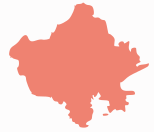Hanumangarh district | |
|---|---|
 Location of Hanumangarh district in Rajasthan | |
| Country | |
| State | Rajasthan |
| Division | Bikaner |
| Headquarters | Hanumangarh |
| Tehsils | Hanumangarh, Nohar, Bhadra, Pilibanga, Rawatsar, Tibi, Sangaria, Pallu. [1] |
| Government | |
| • District collector | Kana Ram [2] |
| Area | |
• Total | 9,656 km2 (3,728 sq mi) |
| Population (2011) [3] | |
• Total | 1,774,692 |
| • Density | 183.8/km2 (476.0/sq mi) |
| Demographics | |
| • Literacy | 67.13% |
| • Sex ratio | 960/1000 |
| Time zone | UTC+05:30 (IST) |
| Vehicle registration | RJ31, RJ49 |
| Major highways | National Highway 54 |
| Website | hanumangarh |
Hanumangarh district is a district in the state of Rajasthan in India. The city of Hanumangarh is the district headquarters and its largest city.


